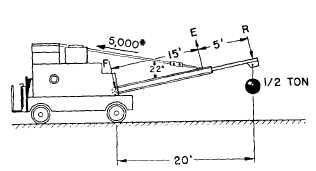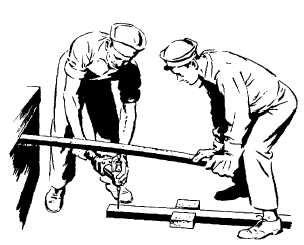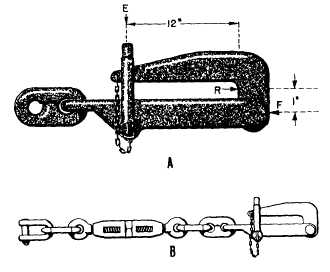Figure 1-13.-An electric crane.
Figure 1-14.-A. A pelican hook; B. A chain stopper.
The wrecking bar is a first-class lever. Notice that it has
curved lever arms. Can you figure the mechanical
advantage of this one? Your answer should be M.A. = 5.
The crane in figure 1-13 is used for handling
relatively light loads around a warehouse or a dock. You
can see that the crane is rigged as a third-class lever; the
effort is applied between the fulcrum and the load. This
gives a mechanical advantage of less than 1. If it’s going
to support that 1/2-ton load, you know that the pull on
the lifting cable will have to be considerably greater than
1,000 pounds. How much greater? Use the formula to
figure it out:
L
R
— = —
l
E
Got the answer? Right. . . E = 1,333 pounds
Now, because the cable is pulling at an angle of
about 22° at E, you can use some trigonometry to find
that the pull on the cable will be about 3,560 pounds to
lift the 1/2-ton weight! However, since the loads are
Figure 1-15.-An improvised drill press.
generally light, and speed is important, the crane is a
practical and useful machine.
Anchors are usually housed in the hawsepipe and
secured by a chain stopper. The chain stopper consists
of a short length of chain containing a turnbuckle and a
pelican hook. When you secure one end of the stopper
to a pad eye in the deck and lock the pelican hook over
the anchor chain, the winch is relieved of the strain.
Figure 1-14, part A, gives you the details of the
pelican hook.
Figure 1-14, part B, shows the chain stopper as a
whole. Notice that the load is applied close to the
fulcrum. The resistance arm is very short. The bale
shackle, which holds the hook secure, exerts its force at
a considerable distance from the fulcrum. If the chain
rests against the hook 1 inch from the fulcrum and the
bale shackle is holding the hook closed 12 + 1 = 13
inches from the fulcrum, what’s the mechanical
advantage? It’s 13. A strain of only 1,000 pounds on the
base shackle can hold the hook closed when a 6 1/2-ton
anchor is dangling over the ship’s side. You’ll recognize
the pelican hook as a second-class lever with curved
arms.
Figure 1-15 shows you a couple of guys who are
using their heads to spare their muscles. Rather than
exert themselves by bearing down on that drill, they pick
up a board from a nearby crate and use it as a
second-class lever.
If the drill is placed halfway along the board, they
will get a mechanical advantage of 2. How would you
increase the mechanical advantage if you were using
this rig? Right. You would move the drill in closer to the
fulcrum. In the Navy, a knowledge of levers and how to
apply them pays off.
1-7





